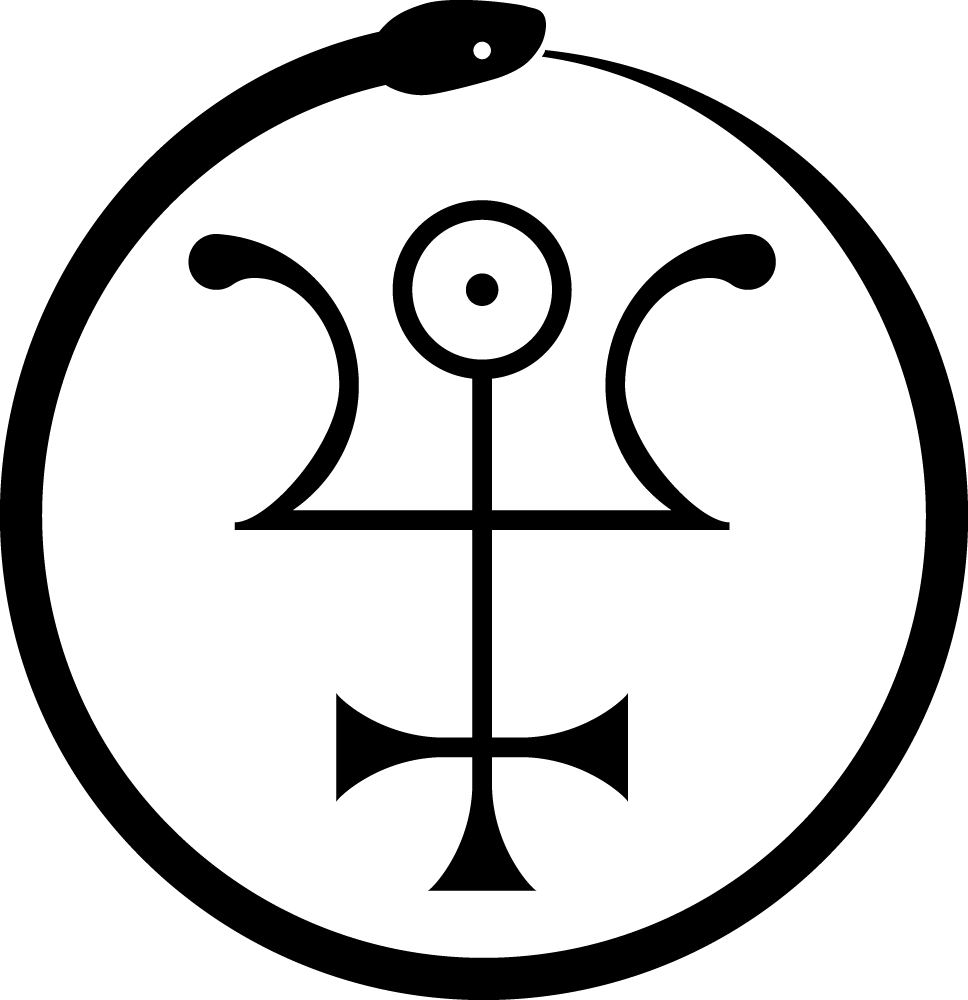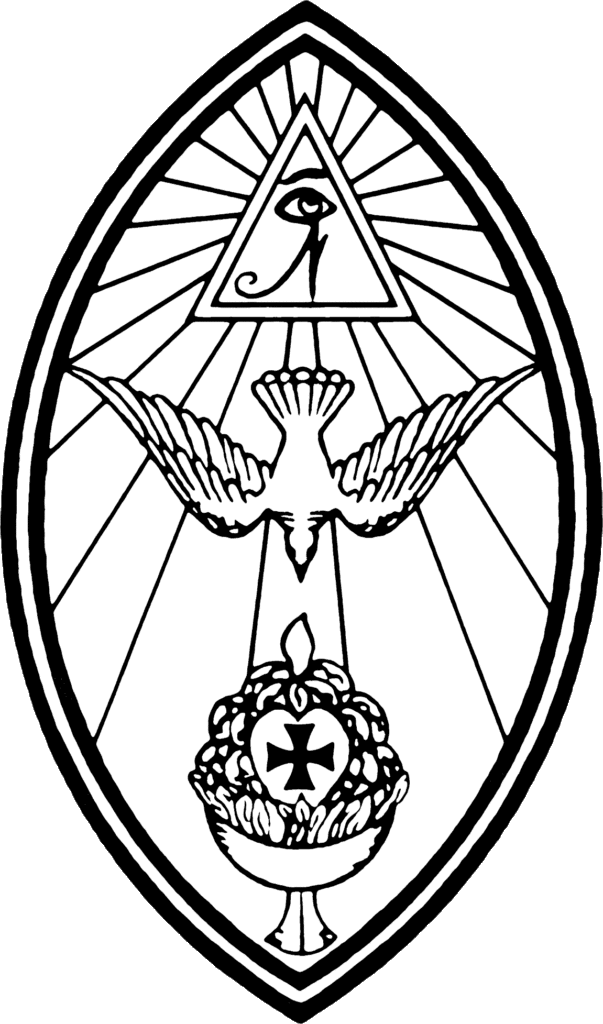The Formula of Tetragrammaton in the Gnostic Mass
by T. Apiryon
Tetragrammaton is a Greek word meaning “Word of Four Letters,” and refers to the Hebraic Name of God, יהוה, which is commonly known in the West as Jehovah. This name has always been held in supreme regard by kabbalists as a Name of great power and symbolic meaning. The letters of this Name have been attributed to the four elements, the four suits of the Tarot, the four worlds of kabbalism, and all other conceivable quaternaries. On the Tree of Life, they are typically attributed to the Sephiroth of Chokhmah, Binah, Tiphereth, and Malkuth. Aleister Crowley describes the Magical Formula of Creation represented by this Word in Magick in Theory and Practice, Chapter 3; and in The Book of Thoth, Part One, Section II and Part Two, Section 0. The reader is referred to these writings for a fuller explanation of some of the basic concepts used in this essay.
Hadit (Kether) is each of the infinite number of infinitesimal points which make up the universe. Nuit (Ain Soph) is the continuous space occupied by the discontinuous Hadit, the Whole of which is divided for Love’s sake by separation of the single point Hadit. The Hebrew letter Yod, י, is by shape a point. The name of the corresponding letter in Greek is iota, which means a “jot” or “bit.” Yod is attributed to the Sephirah Chokhmah, but the uppermost tip of the letter is attributed to that of Kether. The Hebrew letter ה is Heh, which means “window,” referring to an open space. Heh is attributed, among the Supernals, to the Sephirah Binah. The polarity between Yod and Heh, Chokhmah and Binah, can therefore be seen as that of Hadit and Nuit, as reflected down into the Father (Chaos) and the Mother (Babalon).
The Hebrew Letter ו, Vav, attributed to the Sephirah Tiphereth, means “nail,” referring to a fastener, or that which joins two things together. Vav, therefore, reflects the union of the Father and the Mother at point of intersection. By shape, it is an extended Yod: the Father extended downward. The final letter Heh, ה, attributed to the Sephirah Malkuth, represents the manifested result of this union.
Yod is the King, wedded to Heh, the Queen. Their Union brings forth Vav, the Prince, the Heir; and Heh-Final, the Virgin Princess. The mission of the Prince is to make the Princess his bride, to set her upon the Throne of the Mother; and as the Princess becomes the Queen, the Prince is enabled to claim his birthright and thus becomes the King. We read in the Fourth Aethyr of The Vision and the Voice: “And this is that which is written: Malkuth shall be uplifted and set upon the throne of Binah. And this is the stone of the philosophers that is set as a seal upon the tomb of Tetragrammaton, and the elixir of life that is distilled from the blood of the saints, and the red powder that is the grinding-up of the bones of Choronzon.”
Here are a few traditional attributions of the four letters of Tetragramaton:
| Y | Yod | Fire | Chokhmah | Chiah | Atziluth | Will | Magus | Lance | Amfortas |
| H | Heh | Water | Binah | Neshamah | Briah | Memory | Magister | Cup | The Widow/Graal |
| V | Vav | Air | Tiphereth | Ruach | Yetzirah | Cognition | Adept | Sword | Parzival |
| H | Heh-Final | Earth | Malkuth | Nephesh | Assiah | Thoughts | Neophyte | Paten | Kundry |
In the Mass, the formula of Tetragrammaton is constantly repeated on many levels. A few examples follow. The Gnostic and Catholic Church is of Life (Yod), Love (Heh), Light (Vav) and Liberty (Heh-Final). The Officers of the Church are the Priest (Yod), the Priestess (Heh), the Deacon (Vav) and the Children (Heh-Final). The first four points of the Creed refer to Chaos (Yod), Babalon (Heh), Baphomet (Vav) and the Gnostic Catholic Church (Heh-Final).
In The Ceremony of the Introit, Yod the Stele (Chaos, Chokhmah) unites with Heh the Holy Graal (Babalon, Binah) upon the Altar, bringing forth Vav (Baphomet, Aiwass, Tiphareth, the Mind), the Deacon with the Book of the Law, and Heh-Final, the Congregation (the Church, Malkuth, thoughts). The Deacon adds Vav (the Book, the Logos) to the Yod and Heh on the Altar. After the Deacon and the Congregation recite the Creed, which contains an acknowledgement of the forces of Tetragrammaton, another aspect of Heh-Final appears, the Virgin. She completes the formula on the Altar by adding Heh-Final (the Paten, the World). She then, in her serpentine course around the Temple, unites the forces of Yod and Heh of the Altar of Incense and the Font to bring forth another aspect of Vav, the Priest.
In The Ceremony of the Opening of the Veil, the Priest (Vav) exalts the Priestess (Heh-Final) and enthrones her upon the Altar, where she takes the place of the Graal (Heh). The Priest, as Vav/Parsifal, descends and “wanders in the wilderness,” then, rising one step, invokes Nuit (Heh). The Priestess speaks as Nuit, drawing forth the hidden flame of the Priest, enabling him to rise another step and speak as Hadit (Yod). The Deacon and Children arise in recognition, and the Deacon recites the “Calendar” from Chapter II of Liber AL. The Priest rises the third and final step and invokes Horus (Vav). The Priestess responds in kind with “There is no law beyond Do what thou wilt” from Chapter III of Liber AL, and the Deacon (Vav) recites the Collects to the Church (Heh-Final).
In The Consecration of the Elements, the Priest (Yod) and Priestess (Heh), have brought forth a new Vav and Heh-Final, the Elements. These Elements are now exalted to Yod and Heh by identification with the persons of the Priest and Priestess: the Host is identified with the Priest (Yod) and the Cup of wine is identified with the Priestess (Heh).
The Host is round, typifying the Sun, and is made of grain, typifying the Corn of Ceres, which symbolized both the Sun and the Son. In the consecration of the Host, the Priest says, “Life [Yod] of man [Vav] upon earth [Heh-Final], fruit of labour, sustenance of endeavour, thus be thou nourishment of the Spirit!” The Priest then identifies the Host with himself (Yod) with the words, “Touto esti to Soma mou” (This is my body).
In the consecration of the wine, the Priest says, “Vehicle of the joy [Heh] of Man [Vav] upon earth [Heh-Final], solace of labour, inspiration of endeavour, thus be thou ecstasy of the Spirit!” The Priest then identifies the Cup with the Priestess (Heh) with the words, “Touto esti to Potêrion tou Haimatos mou” (This is the Cup of my blood). This identification is sealed when the Priest (Yod) uses the Host (Vav) to make the five crosses upon the Cup, as was earlier done upon the Priestess. The two elements are then elevated.
In The Anthem, the Priest and All invoke the World-Essence, Kether, the source and seed of all.
In The Mystic Marriage and Consummation of the Elements, the Host, symbolic of the Priest, and of Yod as Amfortas, is sacrificed– it is broken in two, and the Particula is removed. The Particula is identified as the seed or Essence of the Priest, the topmost point of the Yod of Chokhmah, i.e. Kether.
The Particula is then placed on the point of the Lance (Yod). The Seed of Kether is transmitted via the Lance of Chokhmah (Yod) into the Cup of Binah (Heh). The result is the Lion-Serpent, Baphomet (Vav). The Priest turns to the People (Heh-Final) and lowers the Lance, drawing down and projecting the invoked Vav Force among them. He makes the sign of the Cross upon them and proclaims the Law, consecrating them to the Great Work. They respond with “Love is the law, love under will,” the Formula of Communion, which prepares them to partake of Communion.
The Priest then consumes the two halves of the fractured Host, saying, “In my mouth be the essence of the life [Yod] of the Sun [Vav].” He consumes the wine, which contains the dissolved Particula, saying, “In my mouth be the essence of the joy [Heh] of the earth [Heh-Final].” The Priest thus integrates the entire formula within himself. “There is no part of me that is not of the Gods.”
The People, having been duly prepared, communicate. They each consume the Yod and Heh and unite them within their bodies. The Vav of their union is then invoked upon them in the Benediction by the Priest: the accomplishment of their own individual True Wills.
With the consummation of the Elements, the officers, as such, have accomplished their True Wills– there is nothing left for them to do. Therefore, the Priestess withdraws herself beyond the Veil, and the Priest, accompanied by the Deacon and the Children, returns to the Tomb from whence he came. The People remain in the Temple– it is now their task to employ the Formula of Tetragrammaton toward the accomplishment of their own True Wills.
Original Publication Date: 5/9/95
Updated: 1/1/08
Originally published in Red Flame No. 2 — Mystery of Mystery: A Primer of Thelemic Ecclesiastical Gnosticism by Tau Apiryon and Helena; Berkeley, CA 1995 e.v.

